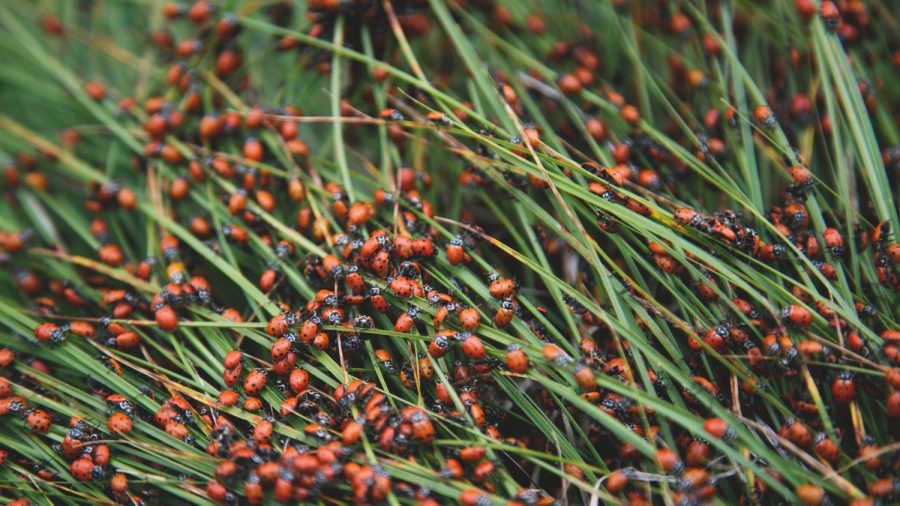A mass of ladybugs in California was so large it showed up on the National Weather Service’s (NWS) weather radar as an 80-mile-wide blob, according to officials.
“The large echo showing up on SoCal radar this evening is not precipitation, but actually a cloud of lady bugs termed a ‘bloom,'” the NWS office in San Diego, Calif., wrote on Twitter on Tuesday, June 4.
The large echo showing up on SoCal radar this evening is not precipitation, but actually a cloud of lady bugs termed a “bloom” #CAwx pic.twitter.com/1C0rt0in6z
— NWS San Diego (@NWSSanDiego) June 5, 2019
While at first glance, the radar reading might appear as a cloud, Casey Oswant—a weather service meteorologist in the San Diego office—told the Desert Sun that the weather that day could not have created the radar readings.
“If you look at the satellite for that area, there weren’t a lot of clouds,” Oswant told the publication.
“This radar return was much larger than what those clouds could’ve been producing,” she added.
Another weather service meteorologist, Mark Moede, told the Desert Sun the agency credited the weather radar readings to the ladybugs after a weather spotter reported high numbers of the insects in the area.
“Our weather spotter said that this happens often,” Moede told the publication. “He said there were ladybugs everywhere.”
An 80-mile swarm of ladybugs was captured on National Weather Service radar in Southern California. A meteorologist says the bugs spread across the sky thousands of feet in the air. https://t.co/psDMHzij4a
— AP West Region (@APWestRegion) June 6, 2019
However, according to another meteorologist with NWS San Diego, Joe Dandrea, the ladybug bloom isn’t in a concentrated mass. He told the Los Angeles Times that he contacted a spotter near where the ladybugs were seen.
“I don’t think they’re dense like a cloud,” Dandrea said. “The observer there said you could see little specks flying by.”
Dandrea added that while the ladybug swarm appeared to be about 80 miles by 80 miles, in reality they’re spread out—about 5,000 and 9,000 feet above ground.
A huge blob that appeared on the @NWSSanDiego radar wasn’t a rain cloud, but a massive swarm of #ladybugs over Southern California. Meteorologist Joe Dandrea says the bugs appeared to be about 80 miles wide as it flew over #SanDiego on Tuesday. https://t.co/Kxuy0vn4CC #cawx pic.twitter.com/KfYrojIegf
— Ed Joyce (@EdJoyce) June 6, 2019
Additionally, he said “the most concentrated mass” would be around 10 miles wide.
However, one expert was skeptical about the ladybug swarm appearing on a radar map.
James Cornett, senior scientist at James W. Cornett Ecological Consultants, told the Desert Sun that the number of ladybugs needed to create such a swarm on the radar equipment would have darkened the skies.
“There would have been unbelievable numbers of telephone calls to the police,” Cornett said. “It merits some investigation.”
Cornett said that while “ladybugs do gather in large numbers during the winter and the fall,” it is very out of character for them to move south this time of year.

Cornett added that if the ladybugs did move, they’d be moving north in search of food. He added that when ladybugs do fly in groups, “we’re talking about thousands of individuals not tens of millions.
Additionally, Cornett said that ladybugs are too heavy to be able to fly high enough to register on a radar.
However, according to the UC Integrated Pest Management Program, ladybugs migrate to higher elevations when they run out of small insects known as aphids to eat in the early summer months.
Despite what different critics may say, people took to social media with their own theories for the ladybug swarm.
Several people commented that the ladybugs were on their way “to the ladybug picnic” from an episode of “Sesame Street.”
To the ladybug picnic obvs https://t.co/WmWJpeTNPr
— A Bit Snitty (@goddamnedfrank) June 5, 2019
Some people were just happy the swarm of insects wasn’t a cloud of locusts.
Well, better than locusts.
— Jill-Marie Jones (@JillMarieJones) June 5, 2019
Another person wondered if there was “any correlation to the earthquakes” that same day.
Any correlation to the earthquakes today? seems like exact path pic.twitter.com/DYOsBrJSNG
— Anarchy for the Soul (@Mutant_Corn) June 6, 2019


